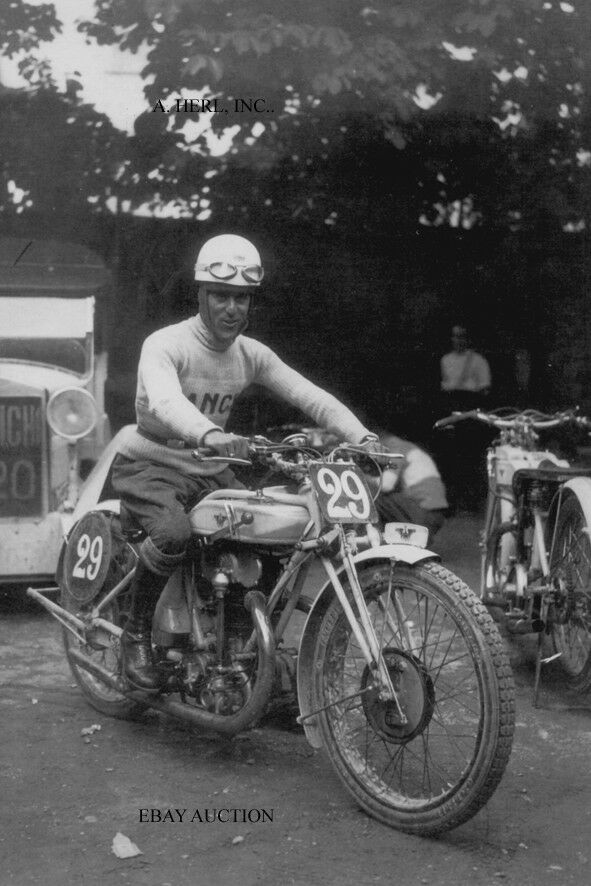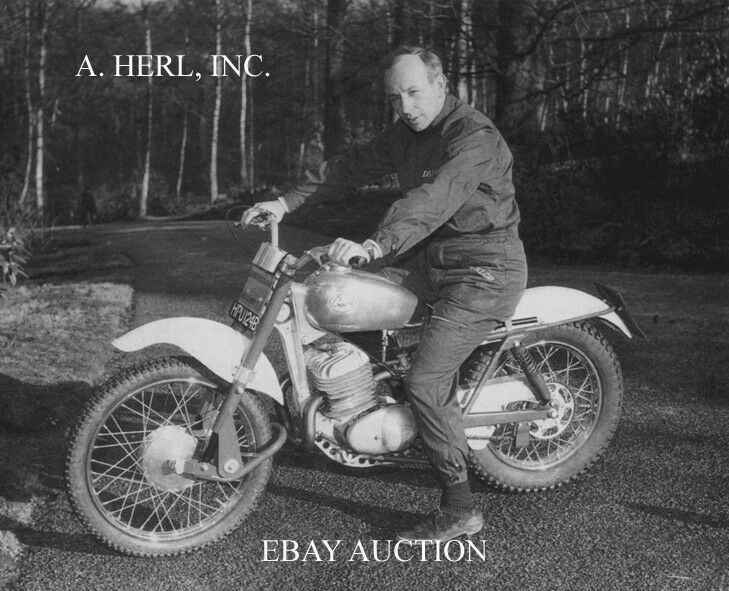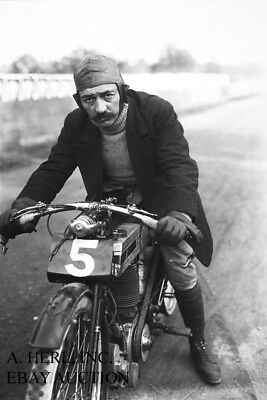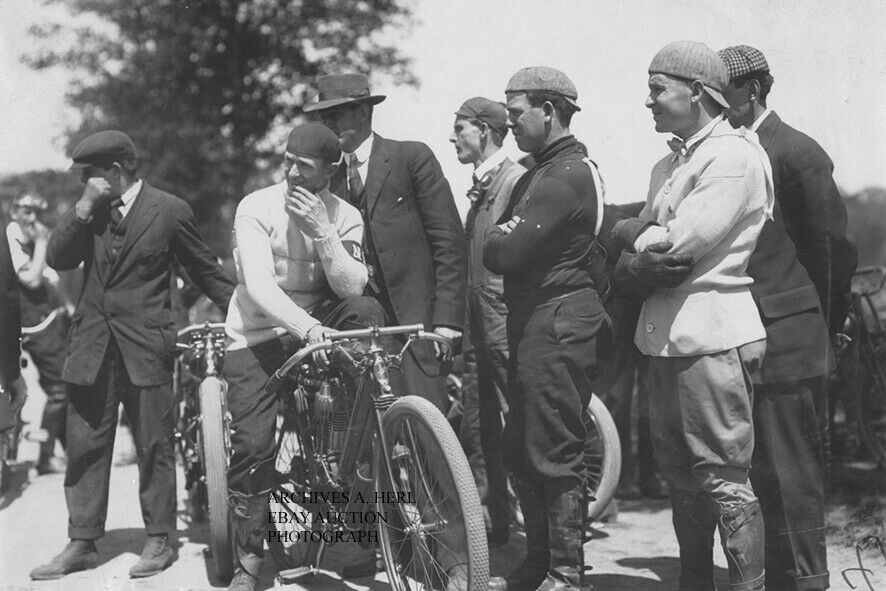-40%
Norton Manx 30M & R.W. Herron 500cc Ulster Grand Prix 1955 photo racing photo
$ 5.14
- Description
- Size Guide
Description
A superb and rare photo ofR.W. Herron
, seen in action with his
500cc Norton Manx 30M 500cc production racer
during the
1955
500cc
Ulster
Grand Prix
which was ridden on
August 13, 1955
. This image shows excellent detail of his great racing machine, which engine was once used by
Artie Bell
! It also is a great shot of one of the most classic and famous roadraces ever: the Ulster Grand Prix.
R.W. Herron
was the brother of J. Herron who raced the
Ulster
in the 250cc class that year. Both brothers lived in the town of
Leitrim
, Banbridge, and were successful roadracers. Interestingly, R.W. Herron was a very active grasstrack racer as well, with his B.S.A. he scored some noticeable victories. When he turned to roadracing he used an engine that came from Artie Bell. Not a bad choice as he shared the fastest and record lap in the 1955 Mid-Antrim “
150”
roadrace with Mick Roche! This great photograph of the Grand Prix of Ulster was taken during the 500cc race of 1955. The race was won by Bill Lomas on a Moto Guzzi with an average race speed of
92.30 mph
(
148.54 km/h
).
Herron is seen riding the
Norton Manx 30M (500cc)
, a machine with a very interesting history. Even though Norton had pulled out of racing in 1954, the Manx would remain the backbone of privateer racing for years to come. It was developed to win the Isle of Man TT from single overhead cam international racers by Norton racing team engineer Joe Craig. The double overhead cam configuration was developed in 1937 and after many problems perfected one year later. The Manx was delayed by the outbreak of World War II but reemerged for the 1946 Manx Grand Prix. The motorcycle was upgraded with new telescopic forks and in 1948 gained twin leading shoe brakes. In 1950 the innovative Featherbed frame was developed, giving the Manx a significant competitive advantage through a low centre of gravity and short wheelbase that was perfectly suited the challenging island TT course. The all-welded, tubular featherbed frame was light and trim, without the usual forgings that added unnecessary weight. In 1950 the featherbed Manx recorded a double hat-trick of podium positions at the TT. The Manx engine was redesigned in 1953 with a much shorter stroke of
86 mm
x 85.6 mm to improve the rev range. 1962 was the last full year for the production Norton Manx. In July AMC announced the transfer of production from
Bracebridge Street
to Woolwich in
London
. 42 Manx Nortons were produced between November 1962 and January
1963. In
1966 Colin Seeley purchased what remained of the spares and tools and which he eventually sold on to John Tickle in 1969. John Tickle took over the Manx name when Norton ceased production and acquired a large quantity of spare parts. He also manufactured complete racers, called the Manx T5 (500) and T3 (350). Both used the short-stroke Manx engines in a frame designed by Tickle but he could not compete against the Japanese racers and sold his stock and the rights in the late 1970s. The stock was bought by Unity Equipe who produce specialist spares and have a complete Triton cafe racer build to order service. In 1994 Andy Molnar purchased the rights to the Manx name and some original tools and spares from Unity Equipe and the Norton Manx is now in complete production again. In January
1961 a
new Norton Manxman 650cc was launched for the American market only. British racer Les Archer worked with frame specialist Ron Hankins and engine tuner Ray Petty to develop a Manx Norton motocross motorcycle. The double-overhead-cam, short-stroke Norton Manx road racing engine was fitted into a Hankins frame and finished with an aluminum tank and titanium axles. The Manx MX was successful, winning the
1956 F
.I.M. 500cc European Motocross Championship, but not able to compete with the emerging two-stroke bikes. Manx Nortons also played a significant role in the development of post war car racing. At the end of 1950, the English national 500 cc regulations were adopted as the new Formula 3. The JAP Speedway engine had dominated the category initially but the Manx was capable of producing significantly more power and became the engine of choice. Many complete motorcycles were bought in order to strip the engine for 500 cc car racing, as Nortons would not sell separate engines. Manx rolling chassis were frequently sold on and paired with Triumph 500cc twin engines to create Triton cafe racers.
The
Ulster Grand Prix
is a motorcycle road race that takes place on the Dundrod Circuit near
Belfast
,
Northern Ireland
. The first races took place in 1922 and in 1935 and 1948 the Fédération Internationale de Motocyclisme gave it the title Grand Prix d'Europe. The Ulster Grand Prix was included as one of the races in the inaugural 1949 Grand Prix motorcycle racing season, a place it held until 1971. It also counted for the TT Championship between 1979 and 1990. According to the race organisers, it is the fastest road race in the world. Thomas Moles, motorcycle enthusiast and Member of Parliament, helped to push through parliament the
first Road
Races Act, which made it legal for the Clady Course to be closed for the first Ulster Grand Prix on
14 October 1922
. That first race had 75 entries in four classes (250cc, 350cc, 600cc and over 600cc). The race has been held on three different circuits. The
20.5 mile
Old Clady circuit was used from 1922 until 1939 and included a notoriously bumpy 7-mile straight. It also ran across part of the grass runway at RAF Aldergrove and for the first two years of its existence the pits were on the Seven Mile Straight, by
Loanends
Primary School
. In 1926 the 500cc race was won by Graham Walker on a Sunbeam. He also won the 1928 Senior race on a Rudge. In the 1936 Lightweight (250cc) event, Ginger Wood and Bob Foster, both on New Imperials, crossed the line so close, that after over
200 miles
of racing, it took the judges an hour to decide that Wood was the winner by one-fifth of a second. Foster was, however, adjudged to have achieved the fastest lap. The 1939 Grand Prix was almost called off, but went ahead in spite of an entry of only 60 riders. After World War II the new Clady circuit was used that, due to road improvements, was now
16.5 miles
in length and in use between 1947 and
1952. In
1953 the race was moved to the
7.401 mile
Dundrod Circuit where it is still held. The event was cancelled in 1972 because of the political situation in
Northern Ireland
and in 2001, during the Foot-and-mouth crisis, when the
North West
200 and Isle of Man TT were cancelled, the race was held. The 2007 Grand Prix attracted an entry of 162 riders, including 38 new riders, and took place on
18 August 2007
, sponsored by The Belfast Telegraph. Joey Dunlop won twenty four Ulster Grand Prix races during his career with Phillip McCallen winning fourteen races and Brian Reid nine wins. Some of the famous riders include: Stanley Woods (7 wins), Jimmie Guthrie, Jimmie Simpson, Artie Bell, Les Graham, Freddie Frith (3 wins), Geoff Duke (3 wins), John Surtees (6 wins), Ray Amm, Carlo Ubbiali (5 wins), Bill Lomas (3 wins), Mike Hailwood (7 wins), Giacomo Agostini (7 wins), Phil Read (3 wins), Bill Ivy (3 wins), Bob McIntyre, Gary Hocking (3 wins), Tom Herron (5 wins), Ron Haslam (5 wins), Jon Ekerold, and more recently Mick Grant, Wayne Gardner, Steve Hislop, Robert Dunlop (9 wins) and Carl Fogarty. The most recent rider to join the famous riders group is Guy Martin (5 wins).
The original
Norton
company was formed by James Lansdowne Norton (Known as Pa) in
Birmingham
in
1898. In
1902 Norton began building motorcycles with French and Swiss engines. In
1907 a
Norton ridden by Rem Fowler won the twin-cylinder class in the first Isle of Man TT race, beginning a sporting tradition that went on until the 1960s – The Isle of Man Senior TT, the most prestigious of events, was won by Nortons ten times between the wars and then every year from 1947 to 1954. The first Norton engines were made in 1908, beginning a line of side-valve single cylinder engines which continued with few changes until the late 1950s. In 1913 the business declined, R.T. Shelley & Co., the main creditors, intervened and saved it. Norton Motors Ltd was formed shortly afterwards under joint directorship of James Norton and Bob Shelley. J.L. Norton died in 1925 aged only 56, but he saw his motorcycles win the Senior and sidecar TTs in 1924.
Designed by Walter Moore, the CamShaft One (CS1) engine appeared in 1927, based closely on the ES2 (pushrod) engine and using many of its parts. On his departure to NSU in 1930, an entirely new OHC engine was designed by Arthur Carroll, which was the basis for all later OHC and DOHC Norton singles. (
Moore
's move to NSU prompted staff to claim that NSU stood for "Norton Spares Used") That decade spawned the Norton racing legend. Of the nine Isle of Man Senior TTs (500 cc) between 1931 and 1939 Norton won seven. Up to 1934, Norton bought the excellent Sturmey Archer gearboxes and clutches. When Sturmey decided to discontinue production, Norton bought the design rights, and had them made by Burman, a manufacturer of proprietary gearboxes. Nortons also appealed to ordinary motorcyclists who enjoyed the reliability and performance offered by single-cylinder engines with separate gearboxes. The marque withdrew their teams from racing in 1938, but between 1937 and 1945 nearly one quarter (Over 100,000) of all British military motorcycles were Nortons, basically the WD
16H
(solo) and WD Big Four outfit (with driven sidecar wheel). After the War, Norton reverted to civilian motorcycle production, gradually increasing the range. A major addition in 1949 was the Dominator, also known as the Model
7, a
pushrod 500 cc twin cylinder machine designed by Bert Hopwood. Its chassis was derived from the ES2 single, with telescopic front and plunger rear suspension, and an updated version of the gearbox known as the 'horizontal' box. Post war, Norton struggled to reclaim its pre-WWII racing dominance, since the single cylinder machine was facing fierce competition from the multi-cylinder Italians, and AJS at home. In the 1949 Grand Prix motorcycle racing season, the first year of the world championship, Norton only made fifth place, and AJS won. That was before the Norton Featherbed frame appeared, developed for Norton by the McCandless brothers of
Belfast
in January, 1950, used in the legendary Manx Norton, and raced by riders including Geoff Duke, John Surtees and Derek Minter. Overnight the featherbed frame was the benchmark by which all other frames were judged. Nortons were winners again. Norton also experimented with engine placement, and discovered that moving the engine slightly up/down, forward/back, or even right/left, could deliver a "sweet spot" in terms of handling. In 1951 the Norton Dominator became available in export markets as the Model 88 with the Featherbed frame. Later, as production of this frame increased, it became a regular production model, and was made in variants for other models, including the ohv single cylinder machines. The racing successes were transferred to the street through Cafe racers, some of whom would use the feather bed frame with an engine from another manufacturer to make a hybrid machine with the best of both worlds. The most famous of these were Tritons - Triumph twin engines in a Norton feather-bed frame. Despite, or perhaps because of the racing successes, Norton was in financial difficulty. Reynolds could not make many of the highly desired featherbed frames, and customers lost interest in buying machines with the older frames. In 1953, Norton was sold to Associated Motorcycles (AMC), who also owned the brands AJS, Matchless, Francis-Barnett and James. The
Birmingham
factory was closed in 1962 and production was moved to AMC's Woolwich factory in south east
London
. Under AMC ownership, a much improved version of the Norton gearbox was developed, to be used on all the larger models within the corporation under the AJS, Matchless and Norton banners. Again, the major changes were for improved gear selection. In late
1955 a
600 cc Dominator 99 appeared.
This is a very nice and very rare non period photo that reflects a wonderful era of 1950s motorcycle history in a wonderful way. This is your rare chance to own this photo, therefore it is printed in a nice large format of ca. 8" x 12" (ca. 20 x
30 cm
). It makes it perfectly suitable for framing!
Contact us for more motorcycle photos of the old and famous American and European motorcycle brands and save on shipping!
Check out our other Ebay auctions or contact us for more motorcycle and car (racing) photos! Combine auctions and save on shipping.
We have more photos listed on Ebay, also motorcycle (racing) and car (racing) photos! Check them out and use the shipping discount! You can always contact us for any requests.
Check out our other Ebay auctions or contact us for more motorcycle (racing) photos! Combine auctions and save on shipping.
Contact us for more motorcycle photos of the old and famous American and European motorcycle brands and save on shipping!
Shipping costs will only be $ 7.00 regardless of how many photos you buy. For 5 or more photos, shipping is free!
(Note: A. Herl, Inc. does not appear on photo, for ebay purposes only)
No copyright expressed or implied. Sold as collectable item only. We are clearing out our archives that we have gathered from various sources.
All items always sent well protected in PVC clear files
and board backed envelopes.
We have photographs that came from professional collections and/or were bought from the original photographer or press studio! They are all of professional and excellent quality.
After many decades of professionally collecting photographs and posters we are clearing out our archives. They make the perfect gift and are perfectly suited for framing. They will look gorgeous unframed and will be a true asset nicely framed with a border. They are a gorgeous and great asset in every home, workshop, workplace, restaurant, bar or club!
First come - first served. And you can always contact us for your requests. Please ask any questions before the auction ends.









